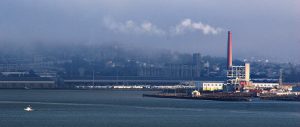Various journalists and advocates have, of late, described America’s Regional Greenhouse Gas Initiative (RGGI) as being near “the brink of failure” thanks to the trend of very low prices of permits to emit carbon dioxide. Likewise, commentators have claimed that Europe’s carbon market, the European Union Emission Trading Scheme (EU ETS), may be “sinking into oblivion” because its emissions allowances too have become very cheap.
Since when are low prices considered a problem? To understand what’s going on, we need to remind ourselves of the purpose – and promise – of a cap-and-trade regime, and then look at what’s been happening in the respective markets.
A cap-and-trade system, if well designed, implemented and enforced, will limit total emissions of the regulated pollutant to the desired level. This is the cap. If the cap is legally binding, it will do this in a cost-effective manner by leading regulated sources – corporations, utilities – each to make reductions until they are all experiencing the same marginal abatement cost. The sources that initially face the highest costs in cutting their carbon emissions reduce less, and the sources that face the lowest abatement costs reduce more, achieving system-wide minimum costs, or cost-effectiveness.
In a nutshell, then, the purpose and promise is to achieve the targeted level of overall pollution control, and, if the cap is binding, do this at the lowest possible cost.
RGGI, a downstream cap-and-trade system for power-sector emissions in 10 north-eastern US states, was launched with relatively unambitious targets. This was principally to keep prices low enough to prevent severe “carbon leakage” – the phenomenon where emissions rise in one area as a result of stricter climate policies in another – from the RGGI region to other states and provinces.
Emissions are capped from 2012 to 2014. Then, starting in 2015, the cap will decrease by 2.5% per year until it is down by 10% in 2019, which would represent a level of emissions 13% below the 1990 baseline. It was originally thought that this figure would be some 35% below the business-as-usual level in 2019, which sounded good back then. What happened is not that the system performed other than designed, but that “business was not as usual”. That is, the region’s unregulated power-sector emissions fell significantly. (See the graph below of the RGGI cap and historical emissions.)
So why did emissions fall in the RGGI States? There are three reasons. First, because of increasing supplies in the United States of low-cost, unconventional sources of natural gas, prices for this fuel have fallen dramatically since 2008. (See the graph below of natural gas and coal prices.) That has meant greater dispatch of electricity from gas-fuelled power plants relative to coal-fired plants, more investment in new gas-fired generating plants, less investment in coal-fired generating capacity and retirement of existing coal-fired capacity, all of which has contributed to lower carbon-dioxide emissions.
Second, the worst economic recession since the Great Depression hit the United States in 2008, causing dramatic reductions in electricity demand in the industrial and commercial sectors and reducing emissions. Third and finally, moderate temperatures in the north-eastern United States have kept down carbon-dioxide emissions linked with both heating and cooling.
For these three reasons, business-as-usual carbon emissions from the power sector in the RGGI states are dramatically below what was originally – and quite reasonably – anticipated. The supply of carbon-dioxide allowances made available at auction is, by law, unchanged, but demand for these allowances has fallen dramatically, hence the fall in RGGI allowance prices. (See the graph below of RGGI allowance prices, 2008-2010.)
Given that emissions are below the RGGI cap, and thanks to natural gas price forecasts likely to remain there, there is no scarcity of allowances. In theory the price should fall to zero, but the system has an auction reservation price of US$1.86 (11.8 yuan) per tonne built in, thereby creating a price floor of precisely this amount.
Does all this mean RGGI is a failure?
No. RGGI may not be particularly relevant, but that does not render it a failure. Rather, a great environmental success has been achieved by the “fortunate coincidence” of low natural-gas prices, economic recession and mild weather. This is hardly something to be lamented.
It’s true that the RGGI system has flaws, such as its narrow scope (it is limited to electricity generation) and lack of a simple safety valve, as I have written about in the past. But today’s low allowance prices are evidence of a success outside of the RGGI market, not failure within it. If the RGGI states have the desire and the political will to tighten the cap in the future, then the system can again become binding, environmentally relevant and cost-effective. That’s an ongoing political debate.
Now, let’s turn to the European Union Emissions Trading Scheme (EU ETS)
Unlike RGGI, Europe’s cap-and-trade scheme has not been irrelevant. It has successfully capped European carbon-dioxide emissions, achieved significant emissions reductions and has done so – more or less – cost-effectively. Unsurprisingly, the EU system also has some design flaws, principally its limited scope and lack of a safety-valve like RGGI. But as with RGGI, its low allowance prices should to some degree be taken as good news, not bad news, and certainly not as a sign of total failure.
Even so, there has been much hand-wringing in Europe over the “failure of the system”. Indeed, Danish Energy Minister Martin Lidegaard said earlier this month that low carbon prices threaten the EU ETS.
Of course, he’s correct that EU ETS allowance prices are “low”. They are down from their historic average of about US$20 (127 yuan) per tonne of carbon dioxide to about US$9 (57 yuan) per tonne currently. In April, they reached an all-time low of US$7.88 (50 yuan). Here’s a graph of EU ETS allowance prices (EUAs) over the crucial period of change, January 2007 to January 2009.
By now, it probably goes without saying that this pattern is partly explained by the global financial crisis, which has hit Europe particularly hard and now threatens a double-dip recession in a number of European nations. Lower European – and global – demand has meant decreased economic activity in Europe, hence lower energy demand and lower carbon-dioxide emissions. This in turn means lower demand and prices for EU ETS allowances.
Even if we assume a growth rate of European carbon dioxide emissions 1% less than the GDP growth rate (represented by the dotted “counterfactual” business-as-usual line in the graph below, which estimates what emissions would have been from 2005 to 2010 without the introduction of the EU ETS) the evidence makes clear that the scheme has succeeded in reducing emissions significantly below what would be expected from the recession alone.
This is where an important caveat needs to be introduced. Also feeding into this depression in permit prices has been a set of national and regional energy policies, such as those promoting the use of renewables. These have served to reduce emissions and demand for allowances, and hence allowance prices. To the degree that the low allowance prices are caused by so-called complementary policies, they do indeed say bad things about public policy. But the problems they point to lie with these misguided policies, which fail to bring about any incremental emissions reductions under the cap-and-trade umbrella while driving up aggregate cost, and not design flaw in the EU ETS itself.
No doubt Minister Lidegaard is aware of the impacts of recession on allowance prices. And I hope he’s aware too of the consequences of these other energy and environmental policies on the market. But he sees the fundamental purpose of the EU ETS as being somewhat broader than the one I described at the beginning of this essay. For him – and many other European observers – “the purpose of the ETS was to cap CO2 emissions in the EU and ensure clear economic incentives for investment in renewables.”
The hand-wringing, then, is not about a failure to achieve emissions reductions cost-effectively, but to have prices high enough to achieve other goals – in this case, greater use of renewable sources of energy; in others technology innovation.
Having multiple policy goals typically necessitates multiple policy instruments. For example, if the goal is a combination of reducing emissions cost-effectively and having prices maintained at some minimum, whether to bring about greater use of renewable energy sources or to inspire more technology innovation, then two policy instruments are needed to do the job. These are: a cap-and-trade system for the first goal, in combination with a carbon tax in the form of a price floor (as RGGI has) for the second.
In other words, the EU ETS has not failed, but the design was inadequate for what politicians now seem to want. If the Europeans want a price floor in their system, then this is certainly feasible, technically and economically. Likewise, if EU member states have the desire and the political will to tighten the cap in the future, there are a variety of ways in which they can accomplish this, rendering the programme more stringent and increasing allowances prices.
In any event, the European Commission’s energy, environment and climate divisions should sort out the real effects of the “complementary policies” that have contaminated the EU ETS, and which drive up costs while failing to bring about additional emissions reductions. Whether any of this is feasible politically is a question my European colleagues and friends can best address.
Robert Stavins is professor of business and government at Harvard University. This article draws on a longer essay first published on his blog, An economic view of the environment under the title “Low prices a problem? Making sense of misleading talk about cap-and-trade in Europe and the USA“.
This article is published as part of our Green Growth project, a collaboration between chinadialogue and The Energy Foundation.
Homepage image by Greenpeace



